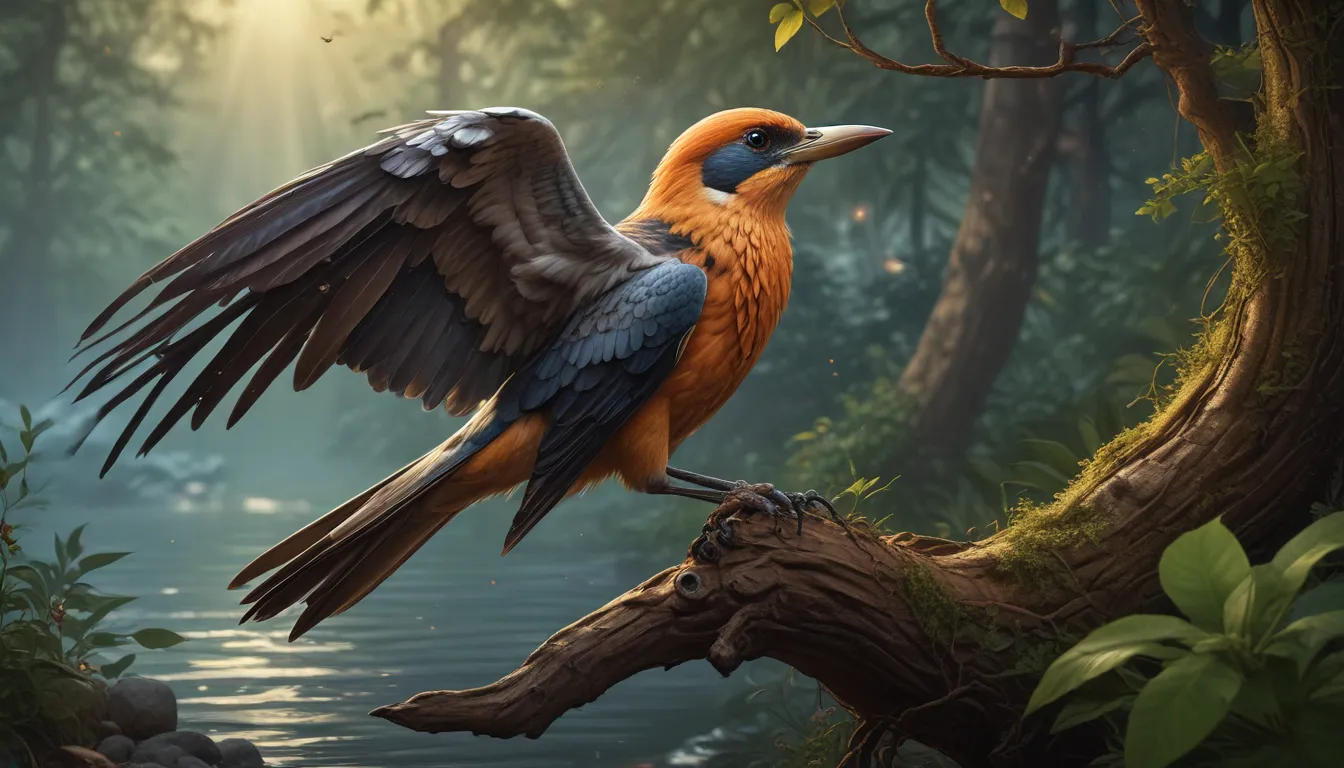The pictures we use in our articles might not show exactly what the words say. We choose these pictures to make you interested in reading more. The pictures work together with the words but don’t take their place. The words still tell you the important facts.
Birds are truly incredible creatures that have captured our imagination for centuries with their beauty, grace, and unique characteristics. From their diverse adaptations to their extraordinary behaviors, birds continue to fascinate nature enthusiasts and scientists alike. In this article, we will delve into 19 fascinating facts about birds that will deepen your appreciation for these remarkable animals. Join us on a journey to explore the amazing world of birds and uncover the secrets of these winged wonders!
Unveiling the World of Birds
Birds are the only animals with feathers, a remarkable feature that enables them to fly and navigate their environment with ease. Feathers provide insulation, aid in courtship displays, and play a crucial role in a bird's survival. Their diverse mating rituals and unique adaptations make birds fascinating creatures to observe and study. From the tiny hummingbird to the mighty ostrich, birds come in all shapes and sizes, each with its distinctive characteristics and behaviors. They play a vital role in pollination and seed dispersal, making them essential to the balance of nature.
Exploring Birds Up Close
1. Birds are the only animals with feathers.
Feathers are unique to birds and serve multiple functions, including enabling flight, providing insulation, and assisting in courtship displays. They are a defining feature of birds that sets them apart from all other animals.
2. The ostrich is the largest bird in the world.
The ostrich, native to Africa, towers as the largest bird species, standing up to nine feet tall and weighing up to 320 pounds. Despite their size, they are remarkable runners, reaching speeds of up to 40 miles per hour.
3. The hummingbird is the smallest bird in the world.
Weighing less than a penny, the hummingbird holds the title of the smallest bird species. Their rapid wing beats allow them to fly backward, upside down, and hover in mid-air, showcasing their agility and precision.
4. Birds have hollow bones.
To reduce weight and enhance flight capabilities, birds have hollow bones filled with air sacs. This unique adaptation makes them lightweight and agile in the air, allowing for efficient maneuverability.
5. Penguins are excellent swimmers.
Despite being flightless, penguins are expert swimmers, diving underwater and reaching depths of over 500 meters. Their streamlined bodies and flipper-like wings enable them to navigate the ocean with grace.
Discovering the Marvels of Bird Migrations
6. The Arctic tern has the longest migration.
The Arctic tern embarks on a remarkable annual migration from the Arctic to the Antarctic and back, covering a staggering distance of over 40,000 miles each year. Their endurance and navigational skills are truly extraordinary.
7. The fastest bird on Earth is the peregrine falcon.
Known for its incredible hunting prowess, the peregrine falcon can reach speeds of up to 240 miles per hour during a hunting dive. With exceptional vision, they are adept at spotting prey from great distances.
8. Birds have excellent color vision.
Birds possess a wider range of color vision than humans, with some species able to see ultraviolet light. This heightened sense of color perception aids them in navigating their environment, locating food, and identifying potential mates.
Experiencing the Diversity of Bird Species
9. The call of a peacock is called a “scream.”
When a peacock vocalizes, it emits a loud, piercing sound known as a "scream." This distinctive call is primarily used by males to attract females during mating season, showcasing the peacock's vibrant plumage and elaborate courtship displays.
10. The kiwi bird is unique to New Zealand.
The kiwi bird, a flightless species native to New Zealand, is the national symbol of the country. Known for its small size, long beak, and nocturnal habits, the kiwi is a beloved and iconic bird of New Zealand.
11. Owls can rotate their heads 270 degrees.
Owls possess a remarkable ability to rotate their heads in almost a full circle, thanks to their flexible necks. This incredible adaptation allows them to locate prey with precision and maintain a wide field of view in their surroundings.
12. The oldest known bird fossil is over 150 million years old.
The Archaeopteryx, a bird-like dinosaur from the Late Jurassic Period, represents one of the oldest known bird species. Its fossil provides valuable insights into the evolution of modern birds and their ancestral origins.
Delving into the Intriguing Behaviors of Birds
13. Some birds are excellent mimics.
Species like the mockingbird and lyrebird possess the remarkable ability to mimic the sounds of other birds and even human-made noises. Their complex repertoire of songs and calls showcases their vocal dexterity and adaptability.
14. Birds play a vital role in pollination and seed dispersal.
As birds forage for nectar or feed on fruits, they inadvertently transfer pollen between plants, aiding in pollination. Additionally, birds assist in seed dispersal by consuming fruits and dispersing seeds in various locations, contributing to plant diversity.
15. The beak shape of birds varies according to their diet.
Birds have evolved a diverse range of beak shapes to suit their specific dietary preferences. For example, finches have short, sturdy beaks for cracking seeds, while hummingbirds possess long, slender beaks adapted for sipping nectar.
16. The avian respiratory system is highly efficient.
Birds have a unique respiratory system that allows for efficient oxygen exchange. Their lungs are connected to air sacs, ensuring a constant supply of oxygen even during flight, a crucial adaptation for their high-energy lifestyles.
Celebrating the Unique Traits of Bird Species
17. Some birds form lifelong pair bonds.
Species like swans, albatrosses, and bald eagles exhibit lifelong pair bonds, working together to build nests, raise offspring, and defend their territories. These strong pair relationships demonstrate the profound social bonds present in certain bird species.
18. Birds exhibit diverse mating rituals.
From intricate courtship dances to vibrant displays of plumage, birds have evolved a variety of mating rituals to attract mates and ensure successful reproduction. These rituals showcase the beauty and complexity of avian courtship behaviors.
19. The 19 Facts About Bird are based on extensive research.
These 19 facts have been compiled from scientific studies and observations conducted by avian experts worldwide. They offer valuable insights into the captivating world of birds and highlight the astonishing diversity and beauty of these feathered creatures.
Embracing the Beauty of Birds
In conclusion, birds are truly fascinating creatures that continue to inspire and captivate us with their remarkable characteristics and behaviors. From their stunning plumage to their awe-inspiring abilities, birds bring joy and wonder to our lives. Understanding and appreciating these avian wonders is not only enriching for us but also crucial for conservation efforts. By learning more about birds and their habitats, we can contribute to the preservation of these magnificent creatures and the ecosystems they inhabit. So, the next time you encounter a bird in flight or hear their melodious songs, take a moment to marvel at the beauty and diversity of the natural world that surrounds us.
FAQs
Q: How many species of birds are there?
A: There are over 10,000 known species of birds in the world.
Q: How do birds fly?
A: Birds fly by flapping their wings, creating lift and propulsion.
Q: Do all birds migrate?
A: No, not all birds migrate. While migration is common among many species, some birds are resident and do not migrate.
Q: How long do birds live?
A: The lifespan of birds varies greatly by species, with some living only a few years and others reaching several decades.
Q: Are all birds able to sing?
A: Singing is predominantly seen in male birds as a means of attracting mates and defending territories, but not all bird species are capable of singing.
Q: Can birds see in color?
A: Yes, birds have excellent color vision and are able to see a wider range of colors than humans.
Q: Are birds intelligent?
A: Yes, birds are highly intelligent creatures, with some species demonstrating problem-solving abilities and tool usage.
Q: How do birds build their nests?
A: Birds build nests using a variety of materials, with each species employing unique nest-building techniques.
Q: What is the largest bird species in the world?
A: The ostrich holds the title as the largest bird species, reaching heights of up to 9 feet and weighing over 300 pounds.
Q: Can birds recognize themselves in a mirror?
A: Some bird species, such as magpies and European jays, have been shown to exhibit self-recognition abilities and recognize themselves in a mirror.
Conclusion: Celebrating the Wonder of Birds
Birds are truly remarkable creatures that embody the beauty, complexity, and diversity of the natural world. Their extraordinary abilities, unique behaviors, and stunning appearances make them a constant source of fascination and wonder for us all. By delving into the world of birds and learning more about their incredible traits, we can deepen our appreciation for these magnificent creatures and contribute to their conservation and protection. So, let us continue to cherish and celebrate the marvels of birds that enrich our lives and connect us to the world around us.






